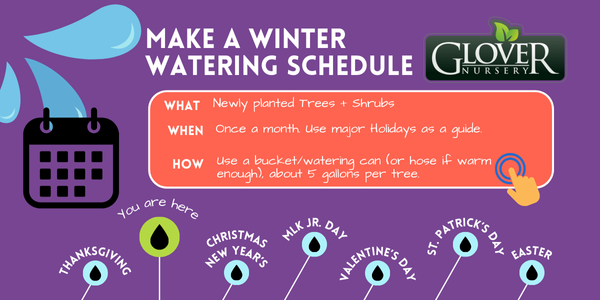We’ve said it and we’ll say it again…
Fall is the best time to plant new trees and shrubs!
Establishing a tree properly takes a bit of extra care in the first few years, so being aware of that powerful fall root growth is important. The deeper the roots grow, the less water you’ll need to give them as they get established. Do not forget the importance of winter watering. Some people think that snow will be enough water for plants, but that’s not true!
After a few years, most trees need very little additional water, as their roots will have spread enough to find adequate water sources to keep the tree growing and strong.
Planting in the Fall
 People often think that because everything is going dormant, now isn’t the right time to plant. That’s a misconception.
People often think that because everything is going dormant, now isn’t the right time to plant. That’s a misconception.
It’s all about the root establishment. While the tree may be going dormant, the roots are not. The brilliance of planting in fall is that the roots will be very active because the tree doesn’t have to focus on growing leaves, fruits, blooms, etc. As long as the ground isn’t frozen, the root mass is growing.
This means a strong, healthy tree come spring!
In addition to giving your new tree the best possible start, autumn is a great time of year to buy new trees and shrubs because many go on sale!
Most stores have stopped bringing in new stock by now and put whatever is left on sale in order to move it out before winter…but, at Glover Nursery, we bring in fresh new plants and instantly put them on sale. Why do we do that? Well, we know that it is such a great time of year to plant and we want to give our customers a great reason to take advantage of the season and get a head start on spring.
Winter Watering
We live in an arid dry region that is experiencing an ongoing drought so, you must be vigilant! Recent years have not yielded much precipitation during winter months, so it is imperative to the health of your plants to supplement with winter watering.
Find out the watering needs for the items you’ve planted. Refer to our planting and watering guide for recommended protocols. Make sure your trees and shrubs are getting enough water throughout the cold months, especially when they are young.
Winter watering is essential. We do not get enough snow in our area to saturate the rootball when temperatures creep above freezing. We’ve got some easy pro tips to help you keep your newly planted trees, shrubs and perennials watered in the winter.
some easy pro tips to help you keep your newly planted trees, shrubs and perennials watered in the winter.
Snow melt will not be enough. That soft, fluffy snow melts down into very little water and does not reach those deep roots where the moisture is needed for the plant to live.
It’s important to remember that the ground does not stay frozen all the time, it thaws and refreezes throughout the season. When it thaws, those little roots are active and searching for a water source.
Trees, shrubs, and even the perennials you planted in the last 2 years will still need winter watering. If you’re not sure how to water in the winter, there are three easy methods:
- Dump ice around the rootball area. When temperatures are warm enough to need it, the ice will melt and soak into the soil around the roots. Take a 16 oz. tumbler and put 1-4 scoops per plant (smaller plants, such as a gallon-size perennial need only one scoop, larger plants like a 25-gallon tree, use four full scoops.)
- Drill a small hole in the bottom of a 5-gallon utility bucket. Place the bucket so that the edge of it is against the trunk of the tree, and fill the bucket with water. Let it drip, slowly, onto the rootball area. Do this once during the winter for smaller plants and 2-3 times for larger trees/shrubs.
- Perhaps most simply of all, pull out the hose! On a sunny, warm day, enjoy some time in the sunshine while you water and deep soak your plants.
Trees To Plant This Fall
Below are Glover Nursery’s Top 12 Trees that are great choices for Utah’s climate and soil conditions.
We continue to bring in more fresh plant material throughout the growing season; we don’t stop until winter is upon us. So, if you are looking to add to your landscape, now is the time!
Oh – and if you want a tree but don’t want to do the hard part, we offer delivery and planting services to make it super easy for you.
Evergreen Trees for Utah
- Austrian Pine
- While the Austrian Pine is native to Austria and the surrounding areas, it is a hugely popular tree in Utah and does extremely well in our conditions. At maturity, it reaches a height between 50–60 ft. with a spread between 20–40 ft. It’s an extremely hardy tree that can handle the heat, drought, and alkaline & clay soils.
- Blue Atlas Cedar
- Blue Atlas Cedar is a slow-growing tree that will top out between 40-60 ft. It’s a popular conifer due to its attractive evergreen blue/silver foliage. Once established, which takes 2-3 growing seasons, the Blue Atlas Cedar is quite drought tolerant.
- Bosnian Pine
- This evergreen is slightly smaller at around 40 ft. tall and 10 ft. wide when it reaches maturity. It gets unique purple cones and is great a great shape for narrow areas. It can be helpful with noise control when planted in a cluster.
- Deodar Cedar
- The Deodar Cedar is native to the Himalayas and gets its name from the Sanskrit words meaning “timber of the gods”. These have been documented to have grown up to 240 ft. in the wild, but will more than likely reach around 70 feet at maturity with a spread of 20-40 ft. in our climate.
- Oregon Green Austrian Pine
- Another variety of Austrian Pine, the Oregon Green is another popular landscape feature. Short and stout, a mature Oregon Green Austrian Pine will reach a height of about 10 ft. and 6 ft. wide. It has dark, green, glossy needles that hold tight to the branch giving the appearance similar to a pipe cleaner.
Deciduous Trees for Utah
- Goldenrain Tree
- Goldenrain trees are delicate and graceful in appearance with yellow blossoms and “paper lanterns” dangling from its branches. Don’t let the delicate look fool you as it is actually quite hardy. It will grow to a height of around 30-40 ft. with an approximate width of 35 ft. These beauties are native to Asia but made their way to the U.S. in 1763.
- Norwegian Sunset Maple
- If you’re looking for a tree with absolutely stunning fall color, this is your tree. Norwegian Sunset Maples grow to about 35 ft. tall. In the autumn, the leaves turn an ombre orange tone that is truly picture-perfect. But don’t think fall is the only season for this tree, oh no! These make for a fantastic shade tree in the hotter months.
- Pacific Sunset Maple
- This is another beautiful fall tree. The beautiful glossy green leaves of spring and summer turn shades of orange, red, and yellow in the autumn. It’s a nice medium size tree growing to about 30 ft. when fully grown. The Pacific Sunset Maple is adaptable to a range of growing conditions and temperatures.
- Zelkova (All Varieties)
- Any variety of Zelkova will be a great addition to your Utah yard. They are easy to grow, drought tolerant, cold hardy, and used for ornamental purposes or as a shade tree. The Green Vase and City Sprite varieties are two of the most popular in Utah, their unique shapes add some beautiful dimensions to add contrast and visual interest to your landscape.
- Crabapple (All Varieties)
- Crabapple trees offer great choices for smaller yards, in park strips, or as a focal point in a garden bed. Their blossoms and fruit will provide lovely pops of color to your landscape, the spring flowers are truly stunning and the fruit will keep the birds visiting throughout the year. However, if the fruit is not something you want, we have fruitless varieties as well. These blossoms are valuable to pollinators, plus, there are all sorts of recipes you can use with the crabapples! As if that weren’t enough, Crabapples do well with Secondary Water.
- Autumn Brilliance Serviceberry
- Despite its name, Autumn Brilliance Serviceberry is brilliant all year round. In the spring, you’ll appreciate the sweet white flowers followed by purple berries in the summer. For their grand finale, they display brilliant autumn colors. These shrubby trees are historically significant as they made their debut to fame having been planted on George Washington’s Mount Vernon estate.
- Streetspire Oak
- As their name suggests, the Streetspire Oak grows thin and tall which makes them more storm-resistant. Their acorns attract wildlife and their dark green leaves turn a lovely rusty red hue in the fall. A great selection for narrow areas.
Before you come into the nursery to pick up your new tree, it is always a good idea to measure the space you’re looking to fill, be aware of the kind of water the tree will receive (culinary or secondary), and know the type of soil native to your yard. We will work with these elements in mind to make sure your selection will thrive for years to come.
If you have any questions about what tree may be right for your yard or how to best water it over the winter, just ask! Our team of experts at Glover Nursery loves to help.


